Wyoming’s population trends provide intriguing insights into the demographics of this expansive state.
With a current population of approximately 586,485 in 2023, Wyoming has experienced modest growth over the years according to Neilsberg.
Between 2010 and 2022, Wyoming’s population grew slowly, typically increasing by an average of 0.2% per year.
Yet, periods of notable increases and decreases hint at underlying social and economic dynamics that influence migration and settlement patterns.
Historical Population Trends

Wyoming has experienced varied population growth and decline over the years. From 2000 to 2023, the state saw an increase of 90,077 people according to Census.gov.
Throughout this period, population growth was not consistent every year.
For instance, the state grew 8 out of 12 years between 2010 and 2022, with the largest annual increase of 1.6% occurring between 2011 and 2012.
Notably, between 2019 and 2020, Utah saw its largest annual increase of 2.5%, reflecting regional population trends.
Conversely, there was a decline of 0.9% from 2016 to 2017. Factors like economic opportunities, migration patterns, and natural population increases or decreases drive such fluctuations.
Age Groups and Population Distribution
Age Group
Male Population
Female Population
0-9
22,000
22,000
10-19
20,000
20,000
20-29
18,000
18,000
30-39
16,000
16,000
40-49
14,000
14,000
50-59
12,000
12,000
60-69
10,000
10,000
70-79
8,000
8,000
80+
6,000
6,000
The population pyramid for Wyoming in 2025 illustrates a balanced distribution between males and females across various age groups. The younger age brackets (0-9 and 10-19) have the highest population counts, each with 22,000 individuals for both males and females.
This suggests a relatively youthful population base, which could have positive implications for the state’s future workforce and economic growth according to World Population Review.
Median Age
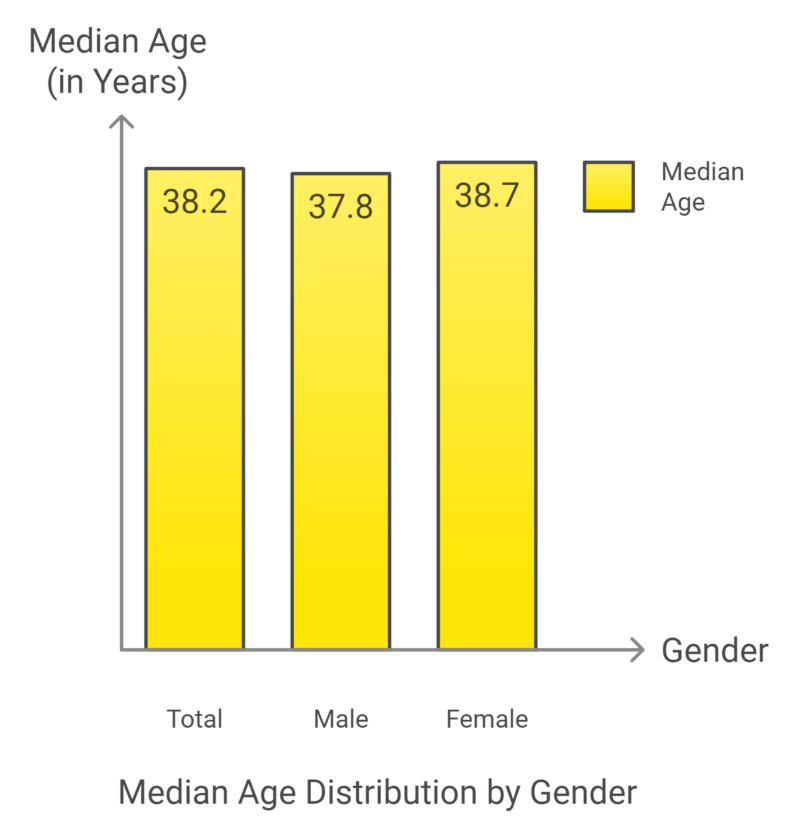
The overall median age in Wyoming is 38.2 years. Males have a slightly lower median age at 37.8 years compared to females at 38.7 years. This slight difference indicates that the female population is marginally older on average, which could be due to factors like higher life expectancy among women.
Wyoming Adults
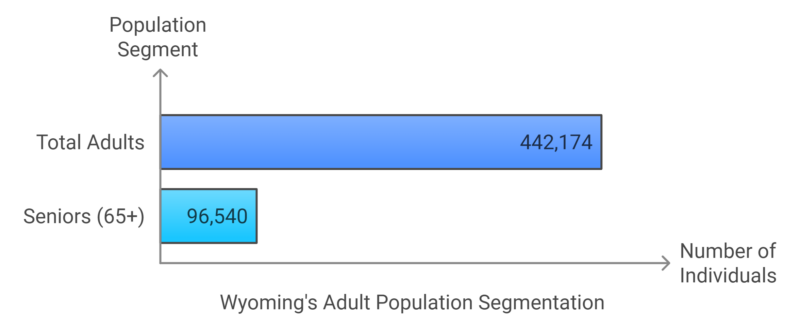
Out of Wyoming’s adult population of 442,174 individuals, 96,540 are seniors aged 65 and above. This means that approximately 21.8% of the adult population are seniors. The significant number of seniors highlights the importance of healthcare services and senior support programs in the state.
Age Dependency Ratios
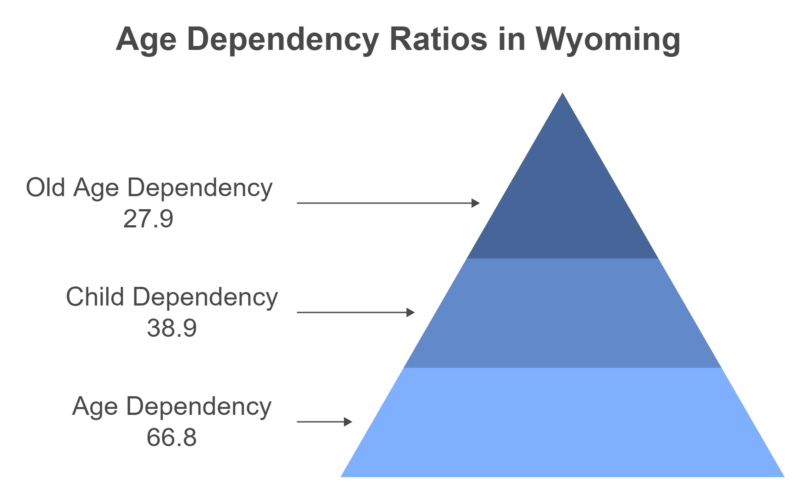
The age dependency ratio of 66.8 indicates that there are about 67 dependents (children and seniors) for every 100 working-age individuals (ages 15-64). The child dependency ratio is 38.9, suggesting a higher proportion of children compared to seniors, whose dependency ratio is 27.9.
These figures suggest that the state may need to allocate more resources towards education and childcare, alongside senior care.
Sex Ratio
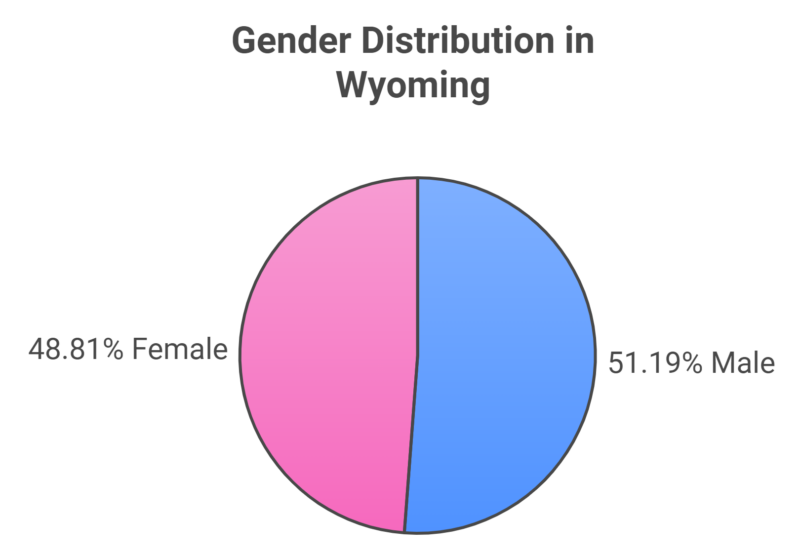
The sex ratio in Wyoming shows a slight male majority, with males making up 51.19% of the population and females 48.81%. This could be influenced by employment opportunities in industries that traditionally attract more male workers, such as mining, agriculture, and energy sectors prevalent in the state.
Racial Demographics
Race
Population
Percentage of Total Population
White
504,798
87.35%
Black or African American
4,891
0.85%
American Indian and Alaska Native
12,359
2.14%
Asian
4,717
0.82%
Native Hawaiian and Other Pacific Islander
636
0.11%
Some other race
16,504
2.86%
Two or more races (multiracial)
34,024
5.89%
According to Neilsberg’s research, the racial composition of Wyoming is predominantly White, comprising 87.35% of the population, reflecting the state’s largely homogenous demographic profile.
Multiracial individuals make up the next largest group, accounting for 5.89%, followed by individuals identifying as “some other race” at 2.86%.
American Indian and Alaska Native populations represent 2.14%, which is relatively higher than the representation of Asian (0.82%), Black or African American (0.85%), and Native Hawaiian and Other Pacific Islander (0.11%) groups.
These numbers reflect Wyoming’s smaller, yet diverse minority populations and emphasize the cultural and ethnic landscape of the state.
Population Growth and Decline
Over half of the cities in Wyoming have a population of less than 500 people.
— World of Statistics (@stats_feed) July 20, 2024
From July 2021 to July 2022, Wyoming’s population grew by around 1,900 people, representing a growth rate of approximately 0.3%, which is slightly below the national average of 0.4%.
This growth was largely driven by migration, with a net gain of 2,494 individuals, indicating more people moving into Wyoming than leaving it.
Most of the counties experienced growth, with Lincoln County leading at a 2.4% increase, particularly in northern parts of the state.
These growth patterns were attributed to several factors, including Wyoming’s natural appeal and economic opportunities that attracted newcomers, despite challenges in retaining young adults seeking education and employment opportunities elsewhere according to Wyoming Public Media.
Birth and Death Rates
Statistic
Rate/Value
Fertility Rate
55.4 (births per 1,000 women aged 15-44)
Teen Birth Rate
16.0 (births per 1,000 females aged 15-19)
Infant Mortality Rate
5.62 (infant deaths per 1,000 live births)
Life Expectancy (at Birth)
76.3 years (2020)
Marriage Rate
7.3 (marriages per 1,000 people)
Divorce Rate
3.3 (divorces per 1,000 people)
Leading Cause of Death
Heart Disease
Drug Overdose Death Rate
21.9 (deaths per 100,000 people)
Firearm Injury Death Rate
20.4 (deaths per 100,000 people)
Homicide Rate
N/A (data not available)
Percent of Births to Unmarried Mothers
32.5%
Cesarean Delivery Rate
27.3%
Preterm Birth Rate
10.42%
Low Birthweight Rate
9.53%
According to CDC Wyoming’s fertility and birth statistics show a moderate fertility rate, a significant teen birth rate, and an infant mortality rate of 5.62 per 1,000 live births. Key health risks include high rates of drug overdoses (21.9 per 100,000) and firearm injuries (20.4 per 100,000), with heart disease being the leading cause of death.
Birth data also reveals that 32.5% of births are to unmarried mothers, and cesarean deliveries occur in over a quarter of all births. These trends indicate areas where health and social programs could focus on improving outcomes in maternal and general public health.
In 2023, Wyoming recorded fewer overall deaths, births, marriages, and divorces compared to previous years, with provisional data from the Vital Statistics Services indicating continued declines in most categories.
There were 5,566 deaths, 5,989 births, 4,061 marriages, and 1,955 divorces recorded in 2023. Suicide deaths rose slightly to 157 in 2023, with 85% involving males and 72% of cases involving firearms.
Drug overdose deaths also continued to increase, reaching 120 in 2023, with opioids being involved in the majority of these cases according to the Wyoming Department of Health.
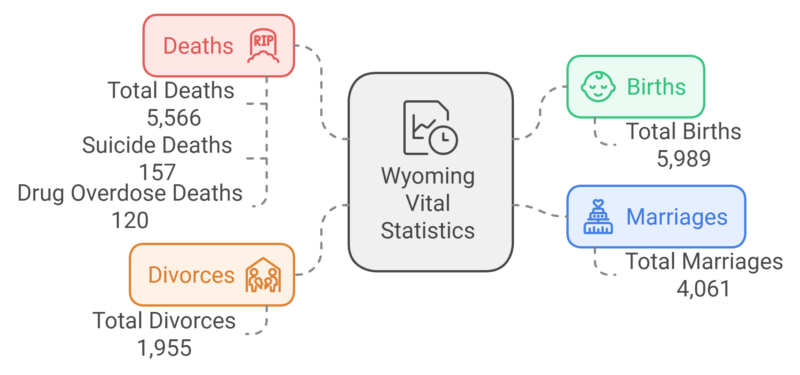
Wyoming Economic Overview 2024
In 2024, Wyoming’s economy shows modest growth across key metrics, with a Gross State Product (GSP) of $41.1 billion, reflecting a 1.3% growth rate over the five years from 2019 to 2024, ranking it 39th among U.S. states. The state’s population is 584k, growing at an annualized rate of 0.2% during the same period, also placing Wyoming 39th in population growth.
Wyoming’s business sector includes 105,330 businesses, with business growth of 3.6%, making it 8th in the state ranking. Major contributors to Wyoming’s economy include Oil Drilling & Gas Extraction (revenue: $17.4 billion), Coal Mining (revenue: $4.1 billion), and Petroleum Refining (revenue: $3.5 billion) according to IBIS World.
Key Economic and Employment Data
Metric
Value
Gross State Product (GSP)
$41.1 billion
GSP Growth Rate (2019-24)
1.3% (Ranked 39th)
Population
584K
Population Growth Rate
0.2% (Ranked 39th)
Total Businesses
105,330
Business Growth Rate
3.6% (Ranked 8th)
Top Industry (Revenue)
Oil Drilling & Gas Extraction – $17.4 billion
Total Employment
271,552
Unemployment Rate
3.5% (Ranked 22nd)
Disposable Income per Capita
$532.2k (Ranked 6th)
- Employment: Wyoming had 271,552 employed people in 2024, growing annually at 1.8%, above the U.S. average of 1.2%. The unemployment rate is 3.5%, down from the previous years, and ranked 22nd among U.S. states.
- Largest Employers: The biggest employers are Walmart (5,016 employees), the University of Wyoming (2,844 employees), and Wyoming Medical Center (1,300 employees).
- Major Employment Sectors: Retail Trade, Healthcare, and Accommodation and Food Services dominate employment, employing 40,238, 36,590, and 32,123 people respectively.
Industry and Sector Highlights
Sector
2024 Revenue
Growth Rate (2024)
Annualized Growth (2019-24)
Oil Drilling & Gas Extraction
$17.4 billion
–
–
Coal Mining
$4.1 billion
–
–
Petroleum Refining
$3.5 billion
–
–
Mining (GDP Contribution)
$7.3 billion
8.6%
1.2%
Real Estate & Leasing
$4.46 billion
1.8%
1.1%
Transportation & Warehousing
$3.62 billion
4.7%
3.3%
Sector Contribution to GDP: The Mining, Real Estate, Transportation, and Warehousing sectors together contributed 49.6% of Wyoming’s total GDP in 2024.
Education
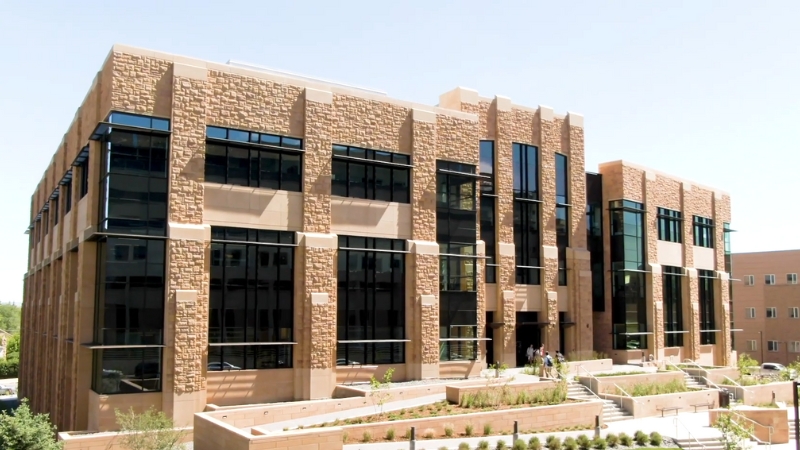
Wyoming ranks favorably in education metrics, particularly in higher education, where it is ranked #2 nationally, while its Pre-K-12 system ranks #19. The state’s education highlights include an average debt at graduation of $10,843, which is below the national average of $14,086 according to USNews.
The high school graduation rate in Wyoming is 81.8%, slightly below the national rate of 85.9%. Additionally, NAEP Math Scores average 281, which is higher than the national average of 274. The University of Wyoming in Laramie ranks as the best college in the state, offering a leading higher education environment.
Metric
Value
Higher Education Rank
#2
Pre-K-12 Rank
#19
Debt at Graduation
$10,843 (National Avg: $14,086)
High School Graduation Rate
81.8% (National Avg: 85.9%)
NAEP Math Scores
281 (National Avg: 274)
Top College
University of Wyoming
Healthcare Access

USNews also states that Wyoming ranks #39 in overall health care, with notable disparities in health care access and quality. The state is ranked #46 in health care access, indicating significant barriers for residents in obtaining services, while health care quality ranks better at #28.
Wyoming’s public health ranking is #35, showing room for improvement in preventative and community health measures.
About 16.6% of Wyoming’s population lacks health insurance, significantly higher than the national average of 11.3%. In contrast, over 95% of Coloradans had health insurance in 2023, highlighting a stark difference in access to coverage between neighboring states.
The preventable hospital admissions rate for Medicare patients is 2,412 per 100,000, which is better than the national average of 2,765 per 100,000. The obesity rate in Wyoming is 34.4%, slightly above the national rate of 33.9%.
Metric
Value
Health Care Access Rank
#46
Health Care Quality Rank
#28
Public Health Rank
#35
Population Without Health Insurance
16.6% (National Avg: 11.3%)
Preventable Hospital Admissions
2,412 per 100,000 (National Avg: 2,765)
Obesity Rate
34.4% (National Avg: 33.9%)
- FUN FACT: Wyoming reported the highest average payout of medical malpractice in 2024 at $2.37M, despite only four claims.
Crime Statistics Overview 2024
Wyoming, with a population of approximately 584k, has seen distinct crime patterns involving both violent and property crimes. This data highlights the number of crimes reported annually and provides a comparison between Wyoming and national averages.
Wyoming Annual Crimes Summary
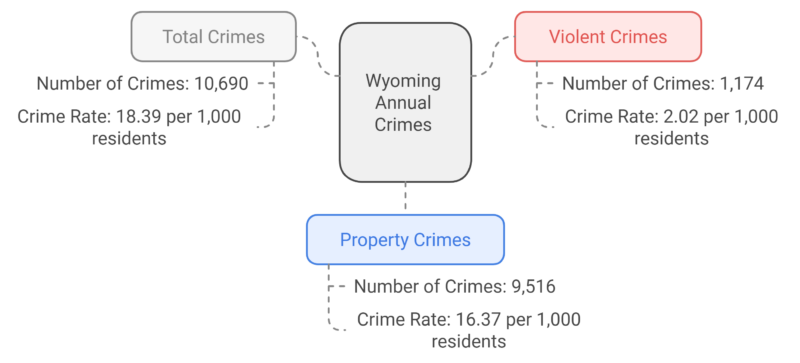
Wyoming has a total crime rate of 18.39 per 1,000 residents, with property crimes being significantly more frequent than violent crimes according to Neighborhood Scout.
Violent Crime Breakdown
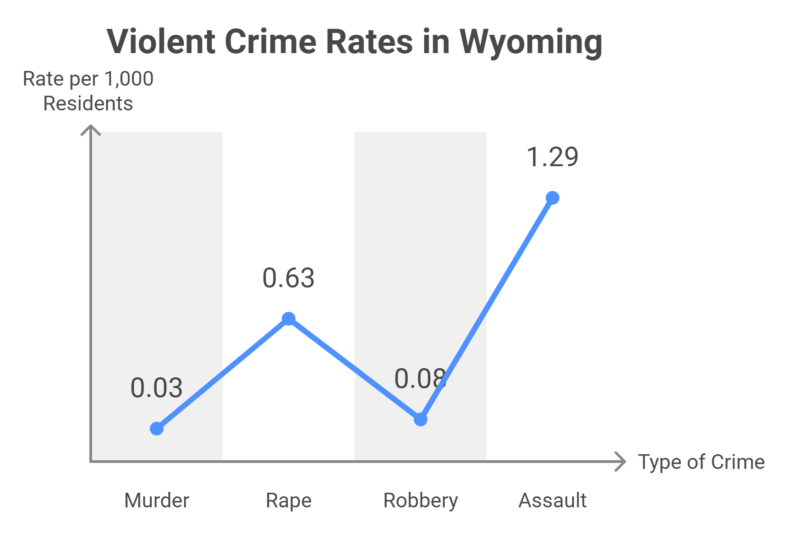
Comparison to National Rates
Crime Type
Wyoming Rate (per 1,000)
U.S. Rate (per 1,000)
Murder
0.03
0.06
Rape
0.63
0.40
Robbery
0.08
0.66
Assault
1.29
2.68
Wyoming’s violent crime rates are generally lower than national averages, particularly in categories like robbery and assault. However, the rate of rape is higher in Wyoming (0.63 per 1,000) compared to the national average (0.40 per 1,000).
Property Crime Breakdown
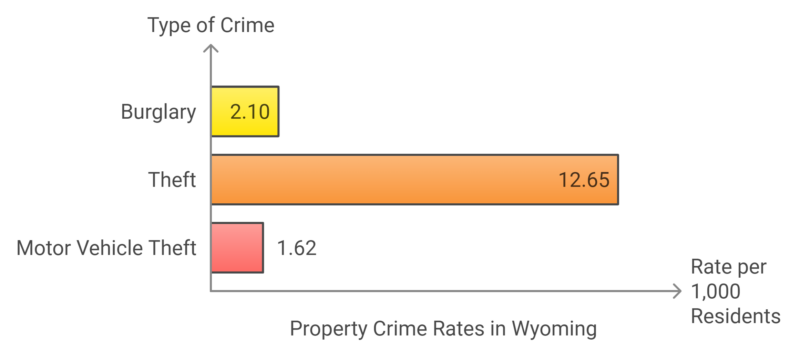
Comparison to National Rates
Crime Type
Wyoming Rate (per 1,000)
U.S. Rate (per 1,000)
Burglary
2.10
2.70
Theft
12.65
14.02
Motor Vehicle Theft
1.62
2.83
Wyoming’s property crime rates are generally lower than the national average. Theft, which is the most common property crime, has a rate of 12.65 per 1,000 in Wyoming, compared to 14.02 per 1,000 at the national level.
Projections for Future Population Trends

Wyoming, often called the Equality State, is renowned for its scenic natural landscapes and independent spirit. It features diverse geographies from the Rocky Mountains to the Great Plains, making it a paradise for outdoor enthusiasts as per Aterio.
Economically, Wyoming is supported by industries like energy, tourism, and agriculture, which contribute to attracting individuals interested in adventure and a strong sense of freedom.
The 2020 Census recorded Wyoming’s population at 581,348, making it the 50th most populous state in the U.S. Forecasted growth suggests a population of 585,484 by 2025 (a 0.2% increase from 2020) and 588,973 by 2030 (a 1.1% increase from 2025).
Population Growth in Top Wyoming Cities
City
2020 Census Population
2025 Projected Population
2030 Projected Population
Cheyenne
64,099
65,653
67,852
Casper
58,287
60,023
61,652
Laramie
32,515
32,437
33,678
Gillette
32,513
32,639
35,694
Rock Springs
23,238
22,835
23,331
Sheridan
17,938
19,016
19,581
Green River
12,025
11,907
12,214
Evanston
11,727
12,332
12,540
Riverton
10,913
10,687
10,910
Jackson
10,585
10,916
11,341
Housing Market
- Total Housing Units: Wyoming has 277,106 housing units.
- Median Home Value: The median value of owner-occupied housing units in Wyoming is $292,300, which is slightly below the national average of $320,900 as per Census Reporter.
- Households: There are 243,321 households in Wyoming, with an average household size of 2.3 people. The state also has 145,766 family households with an average family size of 3.05
Rent and Market Prices
- Median Household Income: The median household income in Wyoming is $70,042, which is a bit below the U.S. average of $74,755. The income per capita stands at $38,114, which also lags behind the national average of $41,804
- Housing Mobility: About 15.4% of residents moved in the past year, which is higher than the national rate of 12.6%. This suggests relatively higher geographic mobility among residents compared to the national average, potentially due to employment opportunities or personal circumstances
Income and Employment
- Labor Force Participation: The labor force participation rate in Wyoming is 65.8%, meaning that a majority of the working-age population is actively engaged in the labor market. The employment rate among those over 16 years is 62.3%.
- Median Earnings: The median earnings in Wyoming are $40,504, with men earning significantly more than women—$52,211 compared to $31,310 respectively, indicating a noticeable gender pay gap as noted by U.S Population.
Methodology for Information Gathering
This report was compiled using a variety of reliable sources to ensure accuracy and comprehensiveness.
Population, housing, and economic data were gathered from Census Reporter and Federal Reserve Economic Data (FRED) to provide up-to-date insights.
Health, education, and employment statistics were sourced from the CDC, US News, and the Wyoming Department of Health.
Each source contributed specific metrics like population trends, median income, housing values, and employment conditions.
The gathered data was then synthesized into a clear, concise narrative to present a holistic view of Wyoming’s demographic and economic landscape.
References:
- Neilsberg – Wyoming Population by Year
- Census.gov – 2020s Total Cities and Towns Population
- World Population Review – Wyoming Population Review
- Utah Population Stats – Utah Population Overview
- Wyoming Department of Health – Wyoming Vital Statistics 2023
- IBIS World – Wyoming Economic Overview
- US News – Wyoming Education Rankings
- Census Reporter – Wyoming Housing Data
- Wyoming Public Media – Population Trends
- Neighborhood Scout – Wyoming Crime Statistics
- Aterio – US Population Forecast for Wyoming
- U.S. Population Stats – Wyoming Economic Insights
Related Posts:
- Wyoming Fatal Crashes in 2025 (So Far) vs. Previous…
- How Dallas' Population Boom Is Changing the…
- Puerto Rico Population in 2025 - Is It Changing?
- Medical Billing Is Changing Fast — What You’ll Be…
- Philadelphia Population 2025 - Current Figures and Analysis
- Colorado Population 2025 - Key Facts and Figures








